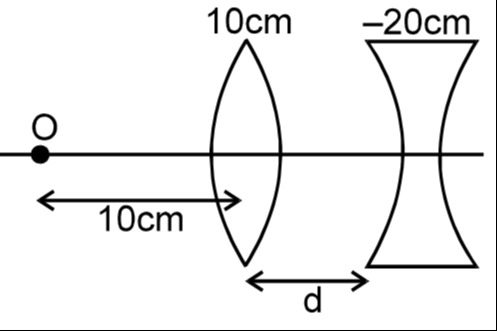Question
Question: 10cm -20cm 10cm d <figure description="Optical diagram showing a point object 'O' on the left, ...
10cm
-20cm
10cm
d

A
10cm
B
-20cm
C
10cm
D
d
Answer
d = 10 cm
Explanation
Solution
Solution:
-
For the converging lens:
- Object distance, u1=10 cm, and focal length, f1=10 cm.
- Using the lens formula: f11=v11+u11⟹101=v11+101 This gives v11=0 so v1=∞ (rays emerging are parallel).
-
For the diverging lens:
- Its focal length is f2=−20 cm.
- Parallel rays (from infinity) incident on a lens give an image distance v2=f2, so here v2=−20 cm (image appears 20 cm in front of the diverging lens).
- Let the separation between the lenses be d (with the diverging lens at x=d) and place the converging lens at x=0. The object O is at x=−10 cm.
- The image formed by the diverging lens will be at x=d+v2=d−20.
- For the final image to coincide with the original object at x=−10: d−20=−10⟹d=10 cm.
Explanation of the Minimal Core Solution:
- For the converging lens: u1=10 cm, f1=10 cm gives v1=∞ (parallel rays).
- For the diverging lens: parallel rays yield v2=−20 cm.
- Final image position =d−20 must equal the object position −10 cm, so d=10 cm.
